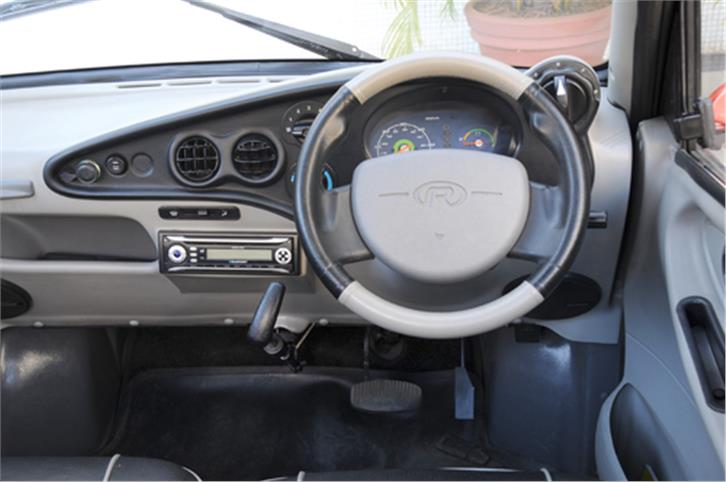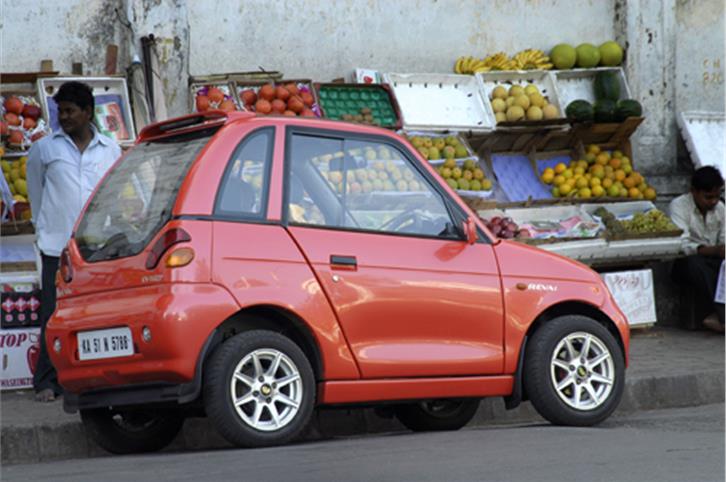Maini Reva-i
What does the Reva-i have that the old Reva doesn't? Read on to find out just how seriously you should consider this electric vehicle.
Published on Dec 18, 2009 08:00:00 AM
17,747 Views
Follow us on

THE FIRST THING that strikes you while walking up to the Reva is its dinky dimensions. This is a small car by any standards with an overall footprint comparable to an auto rickshaw.
Externally there’s very little change, except that the ‘i’ now gets a curved windshield as against the flat glass in the older car. Yes, the car feels a little more spacious, but the fact is it still remains tiny inside. The Reva’s styling has a certain appeal to it in a comical and cute sort of way. The proportions are all awry, the tall stance accentuated by the flat windscreen and large wheels straddling a small wheelbase. The matt grey bumper, which neatly integrates into the nose, stands out. However, body-coloured bumpers are on the cards as well. The body is made from Acrylonitrile -Butadiene-Styrene (ABS) panels that are bolted onto a strong yet lightweight tubular spaceframe. The fit and finish is pedestrian, though on the top-end model you get a music system, an air-conditioner and even climate-controlled seats that blow cold or hot air through vents in the seats!
Whilst the doors are huge and open wide, the insides are incredibly cramped. The driving position is nicely elevated but your head disappears into the roof. Everything around you feels like it has been shrunk one size smaller. The narrow footwell makes it difficult to find the pedals and two large-sized adults may find themselves sitting cheek-to cheek.Space at the rear is even more limited but at a pinch, and an uncomfortable one at that — four medium- sized adults could travel a short distance before circulation to their legs slows down. The rear is best used for kids or small pieces of luggage, which the flip-down seats can accommodate. The good thing about the interiors is the friendly design. The swoopy dashboard, brilliantly styled steering wheel and chunky ‘power’ switch look great and goes to show that good design can even be found in an econo-car.
Turn the ignition and rotate the nice-to-grip switch to ‘F’ and . . . nothing. You only realise that the car is alive when you prod the accelerator. It responds instantaneously and smartly gathers velocity. The high torque motor gives the Reva a certain spring in its step but the truth is that the Reva is woefully underpowered when compared to a regular car. The old Reva took 8.14 seconds to touch 40kph from standstill and 60kph took a full 27.61sec. The new Reva-i takes 7.54sec to reach 40kph and 20.91sec to 60kph. The sprint to 40kph followed by the lag to 60kph is because an electric motor produces maximum torque at zero rpm, performance drops as the speed builds up. When you turn the rotary dial to the more economical ‘N’ mode, the Reva-i gets to the 40 and 60kph figures in 10.76 and 38.79 seconds respectively.
You need a 15 amp socket to charge the eight six-volt lead acid batteries beneath the front seats. If you have a garage, it takes just a few rupees to get your electrician to install a socket, and it’s as simple as charging your mobile. But since we have an open parking lot, we had to drop an extension box with a very long cord out of our first-floor office to charge the car. A full charge takes nine hours, while an 80 per cent charge takes around three. A fully-charged battery, the company claims, will take you around 80km under ideal conditions.
Drive normally and a range of 80km on a full charge is possible, going up to 100km if you’ve switched to E-mode. The best part is the running cost, which is virtually free. Plug the charge cable into an ordinary 15 amp socket and the Reva sucks in only 9 units of electricity and is fully ‘tanked-up’ What does that cost? An average unit of electricity costs Rs 3.50. It takes nine units to fully charge the Reva, ie Rs 31.50, which will comfortably take you at least 50km. That works out to an unbelievable running cost of 60 paise per kilometre
The Reva-i is a hoot to drive. There are no gears to bother about. The heavy battery pack under the seat gives it a low centre of gravity. So despite its tall proportions, you can yank the steering wheel around a corner without feeling it will flip over.
The old Reva had drums all around. The ‘i’ upgrade gets discs in front, but they still lack bite. But it has a trick up its sleeve. When you press the brakes, for the first 20mm of brake travel, it’s the motor itself that’s braking the car, and in the process recharging the battery. The brake hydraulics are not actuated till you press the brake pedal further down. Think about this, if you drive really carefully, the brake pads and discs don’t need to be in contact since the motor is doing all the braking! This regenerative braking means that you are better off braking gently over a longer period rather than braking hard for a shorter period.
The company has worked on the rear suspension, played around with the damping and spring rates and even added an anti-roll bar on the ‘i’. Yet, if you are looking at ride quality, you are better off with a conventional car. The Reva-i is a step-up from the Reva but not enough, yet. Having said that, I would put my money on India’s only EV. As battery technology improves to give greater performance and range, it’s not hard to imagine more people adopting the EV. As volumes rise, the cost of EVs will come down. The running costs may be temptingly low but the only compelling reason to buy one today is a strong desire to save our blue planet.
Tech Specs 
Copyright (c) Autocar India. All rights reserved.

 Price
Price Engine
Engine Body
Body Dimensions
Dimensions
Comments
Member Login
Personal Details
Manna_a2z - 85 days ago
i need this car new please help me shiped kolkata south 24 parganas